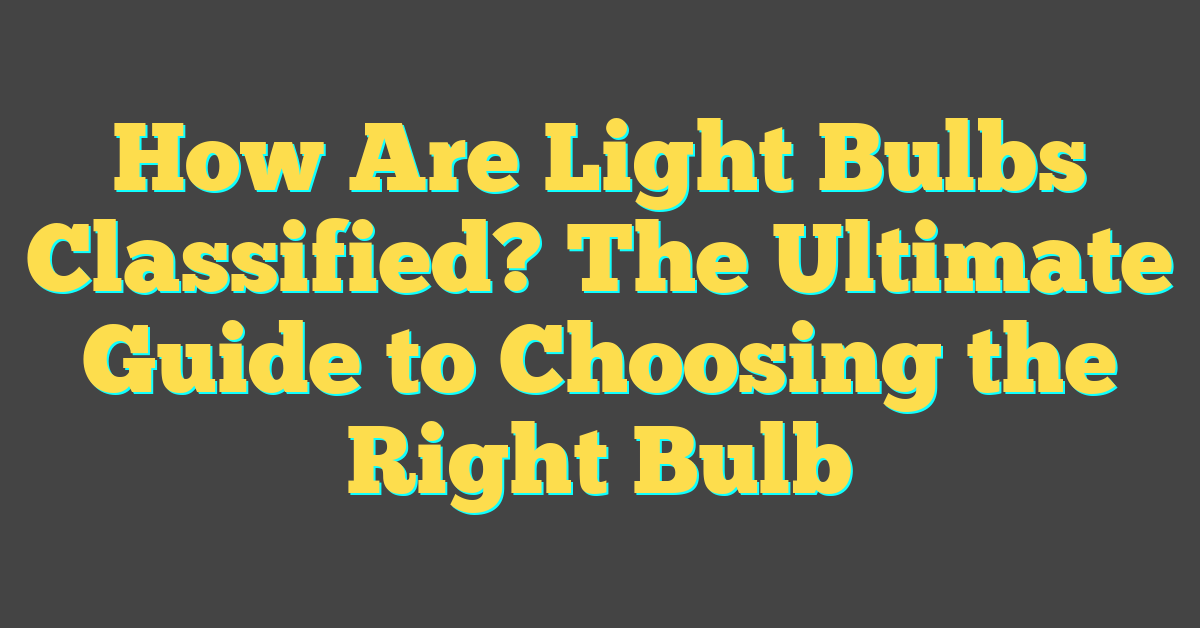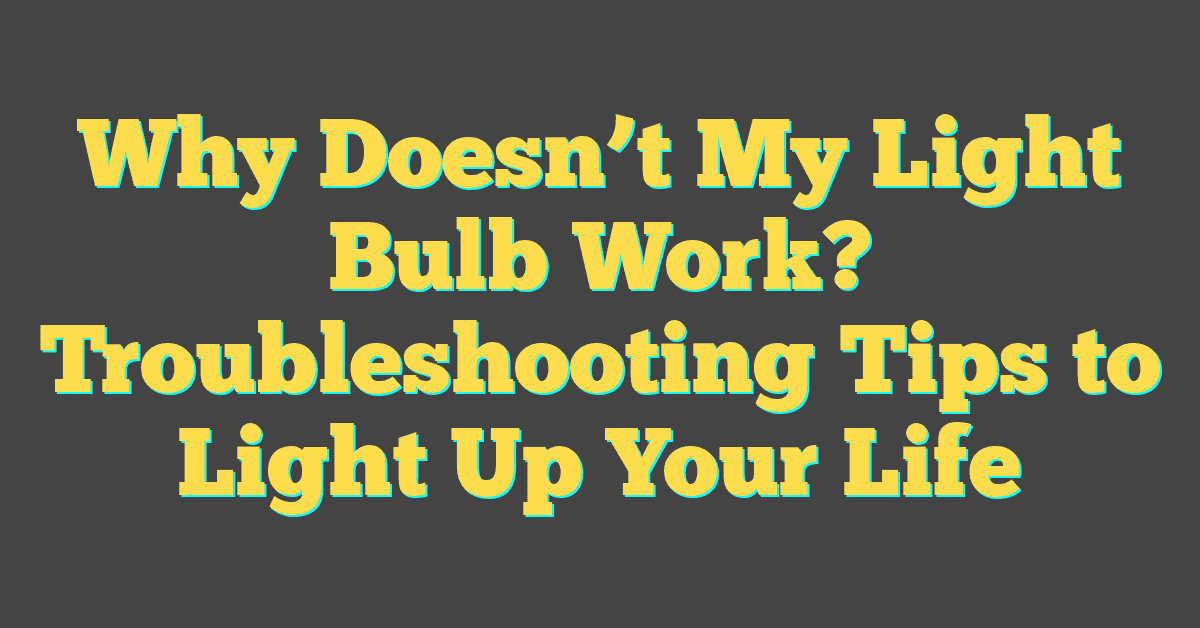Ever wandered down the lighting aisle and felt overwhelmed by the choices? You’re not alone. Light bulbs aren’t just about wattage anymore; they’re classified by type, size, output, and even color temperature. Understanding these categories is like having a secret decoder ring for the lighting world.

Whether you’re looking to set the mood, slash your energy bill, or just find the right bulb for your reading nook, knowing the lingo is key. Let’s shed some light on the subject and break down how bulbs are sorted, so you’ll be equipped to make the perfect pick next time you’re in the market.
Bulb Types
When venturing through the lighting aisle, knowing your bulb types is like having a map in an unfamiliar city. Light bulbs come in primarily three types: incandescent, compact fluorescent (CFLs), and light-emitting diode (LEDs). Each type boasts its own characteristics, suited for different functions around your home and projects.
Incandescent bulbs are your traditional bulbs, often appreciated for their warm, inviting light. They’re akin to a comforting classic, but they’re not your best friend when it comes to energy efficiency. They’ve been largely phased out in favor of options that consume less energy and last longer.
CFLs stepped into the limelight as a more energy-efficient alternative. They cut your energy use significantly and have a longer lifespan compared to incandescents. You’ll often find them with a twisty design, but they do take a moment to reach full brightness, a minor inconvenience for some.
Then you’ve got LEDs, the stars of modern lighting. They consume even less energy than CFLs and last multiple times longer. Whether you’re jazzing up your kitchen or crafting a cozy reading nook, LEDs provide versatility. Moreover, they offer a breadth of color temperatures and are instant-on, illuminating your space without a flicker of hesitation.
- Incandescent Bulbs: Warm light, less energy efficient
- CFLs: More energy efficient, longer warm-up time
- LEDs: Best for energy conservation, longevity, and immediate brightness
Remember, each bulb type affects the ambiance of a room differently. They also impact your energy bills and how often you’re on a ladder, replacing them. So whether you’re illuminating a chic chandelier or brightening up your garage, there’s a bulb out there that will fit the bill perfectly. Keep in mind that as LED technology advances, it’s becoming the go-to for both environmental benefits and cost savings in the long haul.
Bulb Sizes

When you dive deeper into the world of illumination, you’ll find that size really does matter. Picking the right bulb size is as crucial as choosing the type—both for fitting purposes and creating the perfect atmosphere. Let’s break down the common bulb size categories you’ll encounter.
A-Series Bulbs are what most envision when they think of light bulbs. This series ranges from A15 to A23, where the number signifies the bulb’s diameter in eighths of an inch. So, an A19 bulb, typical for household use, is 2 3/8 inches wide.
If you’ve ever glanced at a chandelier and admired its sparkling lights, then you’re probably looking at B-Series Bulbs, often called candelabra bulbs. They are slim, with the B10 being a common size for that elegant touch.
Don’t forget about G-Series Bulbs, the globes. These bulbs are measured in millimeters rather than eighths of an inch, offering a wide and full glow. A G25 globe bulb, often found around vanity mirrors, provides a flawless radius of light for the most accurate reflections.
For those remodeling kitchens or installing track lighting, PAR and BR Bulbs might become your new best friends. Parabolic aluminized reflector (PAR) bulbs offer a focused beam, perfect for accenting certain spaces, while bulged reflector (BR) bulbs cast a wider, more diffuse light, ideal for ambient lighting.
| Bulb Series | Common Size | Diameter | Typical Use |
|---|---|---|---|
| A-Series | A19 | 2 3/8″ | General household |
| B-Series | B10 | Slim | Chandeliers, sconces |
| G-Series | G25 | 25 mm | Vanity mirrors |
| PAR | PAR20 | Variable | Accent lighting |
| BR | BR30 | Variable | Ambient lighting |
Bulb Output

When you’re exploring the world of light bulbs, understanding bulb output is like unlocking the secret to the perfect ambiance. The output of a light bulb is measured in lumens, which tells you exactly how bright the bulb will shine. Want to know a handy tip? The higher the lumens, the brighter the light. It’s that simple!
« Difference Between Light Bulb Bases: Unlock the Mystery of Pin Spacing
What Light Bulbs Look Yellow? Unveil the Perfect Atmosphere for Each Room »
Don’t confuse lumens with watts. For years, you might’ve relied on watts to choose your bulbs – but that’s old school. Watts only show how much energy a bulb uses, not how bright it’ll be. Today’s LED bulbs can deliver the same brightness as old incandescent bulbs but with a fraction of the wattage. It’s not just smart, it’s bright thinking!
Here’s where things get exciting. Check out this quick guide on common bulb outputs:
| Bulb Type | Lumens |
|---|---|
| 40W Incandescent | About 450 lumens |
| 60W Incandescent | About 800 lumens |
| 75W Incandescent | About 1100 lumens |
| 100W Incandescent | About 1600 lumens |
| 10W LED (equivalent to 60W incandescent) | About 800 lumens |
With advancements in bulb technology, LEDs are revolutionizing the game. They give you the same inviting glow as old bulbs but last so much longer and sip electricity like a fine wine. They’re energy-efficient champions.
Don’t forget color temperature! Measured in Kelvins, this helps determine the color of the light ranging from warm yellows to cool blues. It’s like choosing between that cozy, fireside light, and that crisp, morning sunlight. Whether you’re setting up for a movie night or need a bright workspace, there’s an LED out there with your name on it.
Bulb Color Temperature

When you’re knee-deep in the world of lighting, one term you’ll often encounter is “color temperature.” Unlike the warmth or coolness you might feel from the sun’s rays, color temperature in lighting refers to the color emitted by a light bulb. Measured in degrees Kelvin (K), it affects the mood and functionality of a space. Lower Kelvin numbers mean the light appears warmer, giving off a cozy, amber hue—perfect for relaxing. In contrast, higher Kelvin values yield cooler, bluer light, conducive to concentration and alertness.
Here’s what you need to know about various color temperatures:
- Soft White (2700K – 3000K): Creates a warm, calm atmosphere, ideal for living rooms and bedrooms.
- Bright White/Cool White (3500K – 4100K): Emits a more neutral white light, suitable for kitchens and bathrooms where tasks need clarity.
- Daylight (5000K – 6500K): Resembles noon on a cloudless day and is best for places where fine detail is important, like a home office or workshop.
Delving into DIY home projects, you’ll discover that color temperature plays a key role in setting the right ambiance. Imagine you’re installing a vintage-style LED bulb above your reading nook—opting for a 2700K bulb can make the space inviting, much like the warm glow of a traditional incandescent lamp. On the other hand, swapping out the bulb in your garage for a 5000K LED can transform it into a bright, energetic environment, making those DIY tasks a little easier on the eyes.
Advancements in bulb technology have also led to the advent of tunable white lighting. These innovative bulbs allow you to adjust the color temperature on the fly, catering to the changing use of a room, all with a simple tap on your smartphone or a voice command. So whether you’re revamping your lighting scheme or simply replacing a burnt-out lamp, remember that Kelvin counts. Your choice can uplift your décor, influence your mood, and even enhance your productivity.
Choosing the Right Bulb

Now that you’ve got a handle on color temperature, it’s time to dive into selecting the perfect bulb for your space. The choice can be overwhelming, but here’s a rundown to clear things up. You’ll want to consider several key factors: bulb type, lumens, and energy efficiency.
Bulb type is your starting point. There are incandescents, halogens, compact fluorescents (CFLs), and light-emitting diodes (LEDs). Incandescents are your old-school option, loved for their warm light but not so loved for their energy consumption. Halogens are a bit better on efficiency and brighter, while CFLs offer significant energy savings. However, LEDs are the cream of the crop in terms of energy efficiency and lifespan. Whether you’re installing a vintage Edison bulb in an exposed fixture or an LED downlight in your kitchen, there’s a bulb for every nook and cranny of your home.
Next up, lumens. Forget about watts; lumens are where it’s at for brightness. A higher lumen count means a brighter bulb. Need to illuminate your home office for those DIY project plans? Aim high. Cozy reading nook? Go lower. Here’s a quick reference guide to clear the air:
| Application | Lumens |
|---|---|
| Reading & Task | 400-800 |
| General Room Light | 800-1600 |
| Outdoor Areas | 1600+ |
Lastly, consider energy efficiency. Not only is it good for the planet, but it’s also great for your wallet. LED bulbs top the charts, requiring less power for more light, followed closely by CFLs. In fact, swapping out just one incandescent bulb for an LED can save you a chunk of change each year on your electricity bill.
Don’t forget about bulb shapes and bases too. The design of the bulb can affect the distribution of light and can either complement or disrupt the aesthetics of your space. Standard shapes like A19 are versatile, while globe or candle shapes can offer a more decorative touch. It’s like choosing the right accessory for your outfit – it’s all in the details!
Conclusion
Armed with this knowledge, you’re now ready to make an informed decision when selecting the perfect light bulb for your space. Remember that the right choice balances brightness, energy efficiency, and aesthetics to create the ideal ambiance. Whether it’s the warm glow of an incandescent or the long-lasting brilliance of an LED, your lighting can transform any room. So go ahead, choose wisely, and light up your world just the way you like it!
Frequently Asked Questions
What factors should I consider when choosing a light bulb for my space?
You should consider the bulb type (incandescents, halogens, CFLs, LEDs), lumens for brightness, energy efficiency, and the shape and base of the bulb to ensure it fits your aesthetic and functional needs.
What are the different types of light bulbs available?
The main types of light bulbs available are incandescents, halogens, compact fluorescents (CFLs), and light-emitting diodes (LEDs), each with unique advantages and disadvantages.
Why is it important to consider lumens when buying a light bulb?
Lumens measure the brightness of a bulb. Choosing the right amount of lumens ensures that your space is adequately illuminated according to your needs.
Are LED bulbs more energy-efficient than other types?
Yes, LED bulbs are typically more energy-efficient compared to other bulb types, have a longer lifespan, and can save you money on your electricity bill in the long run.
How do bulb shapes and bases affect my choice?
Bulb shapes and bases contribute to the overall look and feel of your space. The right shape and base ensure the bulb fits properly in your fixture and complements your room’s design.




